Betta fish are a popular freshwater fish that have captured the attention of fish enthusiasts around the world. These vibrant, colorful fish are known for their unique body shape, long fins, and aggressive behavior towards other Betta fish.
Originally from Thailand and other parts of Southeast Asia, Betta fish have a rich history and culture surrounding their breeding and care. With over 10 different types of Betta fish, each with their own distinct physical characteristics, Betta fish offer a diverse and exciting aquarium experience for both novice and experienced fish keepers.
In this blog post, we will explore 41 different Betta fish types based on their physical characteristics. Whether you’re a first-time Betta fish owner or a seasoned aquarium hobbyist, this guide will provide valuable insights into the fascinating world of Betta fish.
See also:
- How Many Betta Fish In A 10 Gallon Tank: Useful Guide
- Top 11 Best Place To Buy Betta Fish Online: Basic Tricks To Choose
- Do Betta Fish Change Color: 4 Most Common Reasons
Betta Fish Types By Tail
Betta fish are easily recognizable by their unique tails, which come in a variety of colors and shapes depending on the type of Betta. It’s important to understand the different tail types of Betta fish not just for their visual appeal, but also for gaining insight into their genetics and care requirements. By understanding their tail types, you can determine the appropriate level of care and maintenance necessary to keep them healthy and happy.
Veiltail Betta fish
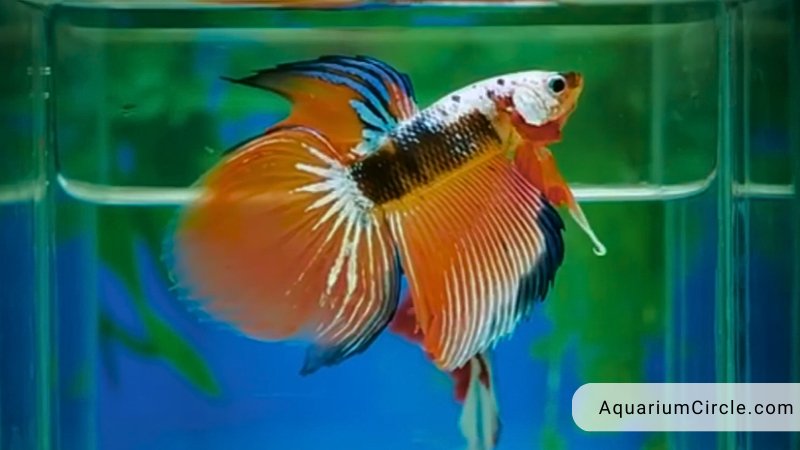
The Veil tail is the most popular type of tail for Betta fish due to its long, flowing, and downward-swooping appearance. This tail type gets its name from the shimmery and translucent effect that looks like a veil as the fish swims. Veiltails are an excellent choice for beginner Betta fish keepers due to their availability and low maintenance requirements.
Female veiltail betta are brighter in color and have shorter fins than male betta.
Crowntail Betta fish
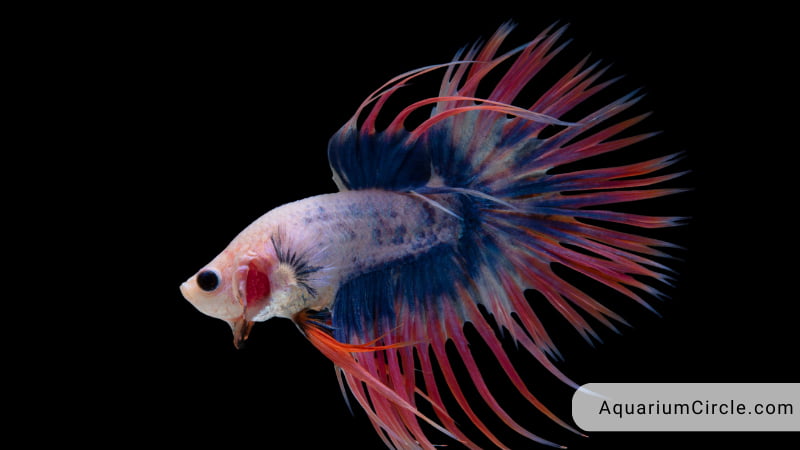
The Crowntail Betta Fish is another popular type due to its spiky fins, resembling a crown. These fish can be easily identified by the elongated rays on their fins and the small amount of webbing present. If the webbing extends beyond two-thirds of the ray’s length, it is not considered a Crowntail. Breeders generally aim for the webbing to only reach halfway up the ray, resulting in a more pronounced spiky appearance.
Combtail Betta fish
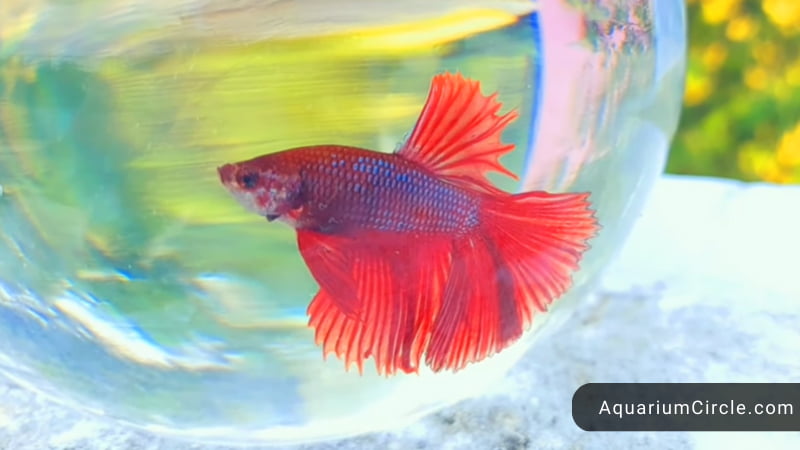
The Combtail Betta is a type of Betta fish with longer rays in its tail than webbing, similar to the Crowntail. However, Combtail Betta fish utilize this feature more subtly, with a less noticeable difference between the fin’s ray and webbing. These fish commonly have a fan-like caudal fin, with a generous spread that usually does not exceed 180 degrees.
Double tail Betta fish
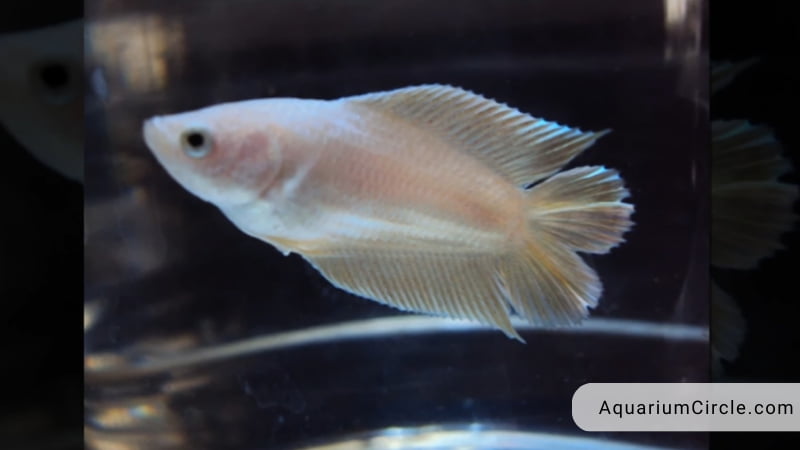
The Double Tail Betta is a type of Betta fish with two distinct tails that separate at the base, rather than just being split. This separation is due to the presence of caudal peduncles where the tails attach. Double Tail Betta fish typically have larger dorsal and anal fins compared to other Betta types, and their bodies tend to be shorter in length.
Spade tail Betta fish
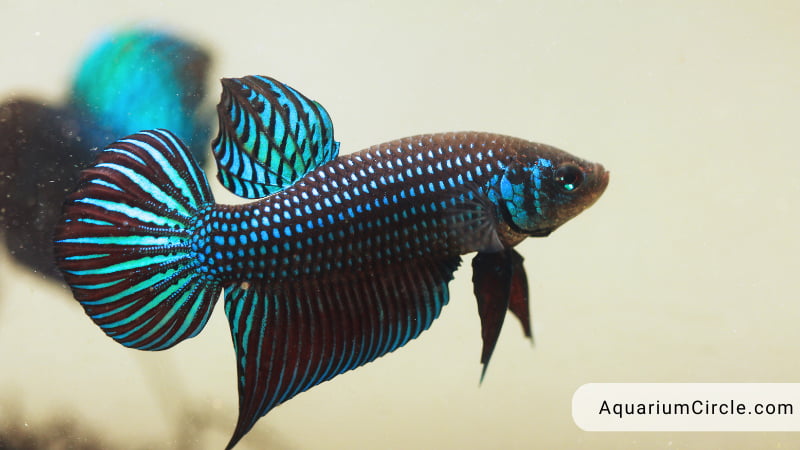
The Spadetail Betta is a type of Betta fish with a caudal fin that resembles a spade, hence its name. The tail has a wide base that narrows smoothly, similar to a round tail Betta, but with a distinct single point instead of a round shape.
Halfmoon Betta fish
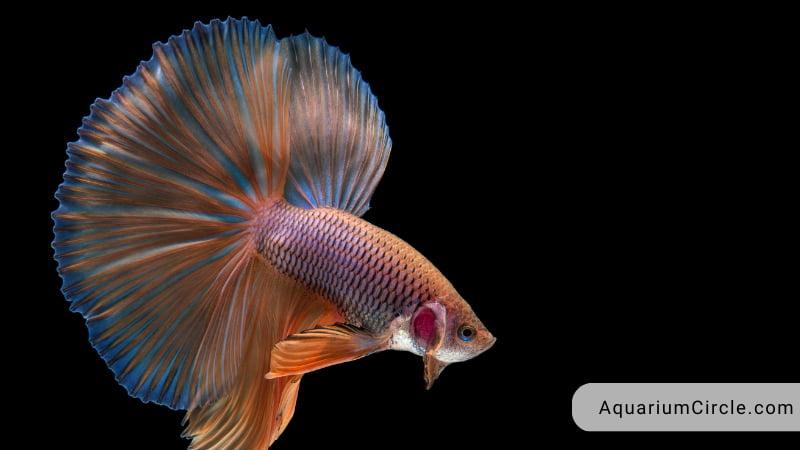
The Halfmoon Betta is a type of Betta fish with a caudal fin that has a wide spread of approximately 180 degrees, resembling a capital letter D. In addition to the generous width of their caudal fin, Halfmoon Bettas also have wider anal and dorsal fins compared to other Betta fish varieties.
Over-half moon Betta fish
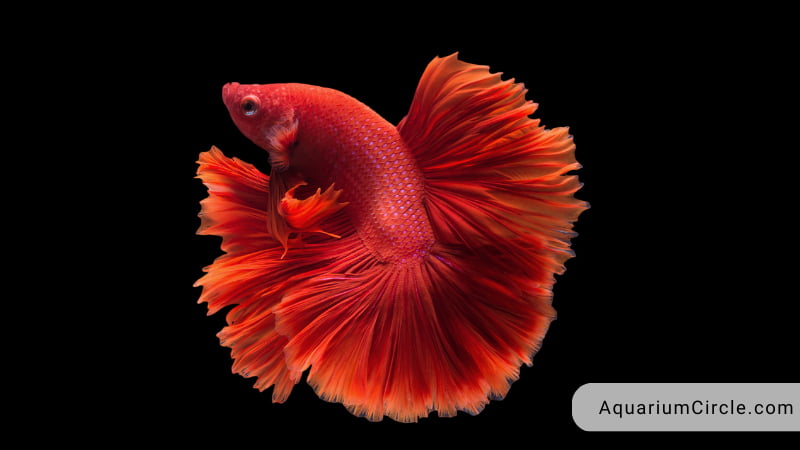
The Over-Halfmoon Betta has fins similar to Halfmoon Bettas, but with a more extensive spread of over 180 degrees when flared, resulting in a shape larger than half a circle.
If you’re considering adding an Over-Halfmoon Betta to your aquarium, it’s essential to note that they tend to be more aggressive than other Betta types. To avoid threatening behavior, choose tank mates wisely, and house only a single male Betta fish in a tank. However, adding a female Betta will not affect the behavior.
Delta Betta fish
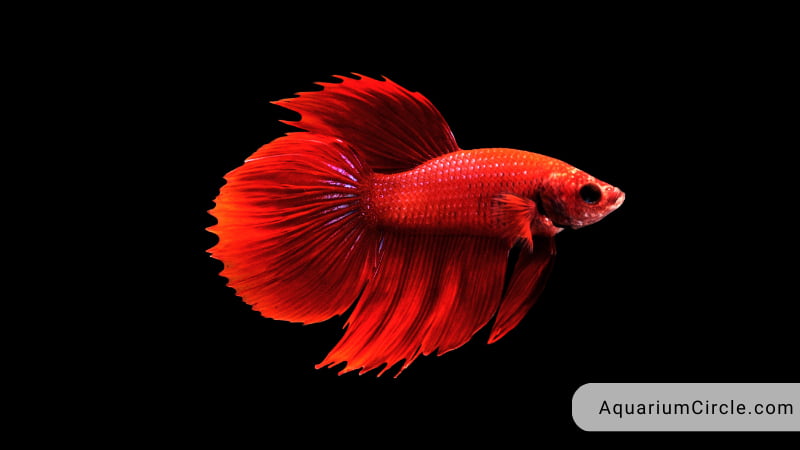
The Delta Tail Betta is a type of Betta fish with a triangular-shaped tail that narrows towards the body and widens towards the tip, resembling the letter D in the Greek alphabet. Although it looks similar to the Halfmoon, the Delta Tail has a smaller tail that does not reach 180 degrees.
Super delta Betta fish
The Super Delta Tail Betta is similar in appearance to the Delta Tail Betta. However, the main difference is that the Super Delta Tail has a flared tail that spans between 120 to 160 degrees, while the Halfmoon Betta has a fan that reaches 180 degrees. Additionally, Super Delta Tail Bettas do not have crowning or combing on their rays, and the edges of their tail have webbing and do not look spiky.
Half sun Betta fish
The Half Sun Betta is a product of selective breeding between Crown Tail and Halfmoon Bettas. This type of Betta fish has a tail with a 180-degree spread, similar to the Halfmoon, and an extended caudal fin webbing like the Crown Tail. Although visually stunning, Half Sun Betta fish can be quite aggressive, so it’s essential to carefully select other Betta varieties to keep in the fish tank.
Rose tail Betta fish
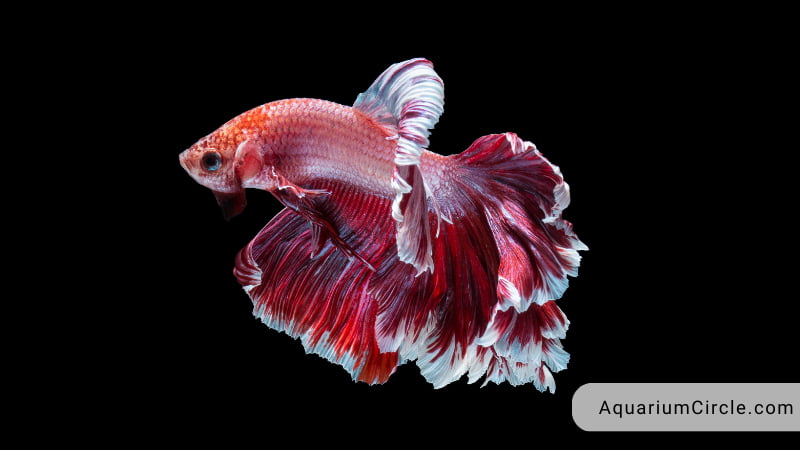
The Rose Tail Betta is a stunning variation of the Halfmoon Betta, with the most significant difference being excessive branching on the rays of its fins, resulting in an overlap that creates a rose-like appearance.
However, the rose-like tail can be heavy, making it challenging for the fish to swim, especially as it grows older and becomes heavier. Despite this disadvantage, adding a Rose Tail Betta to a dorm room can undeniably be a beautiful addition to the color scheme.
Feather tail Betta fish
The Feather Tail Betta has ruffled anal, caudal, and dorsal fins, similar to the Rose Tail Betta. However, the Feather Tail Betta looks more wild and unkempt, resembling a crossbreed between a Crown Tail and a Rose Tail. It’s considered one of the most visually stunning types of Betta fish, with a tail that resembles feathers and creates a stunning trail as the fish moves.
Plakat/Shortfin Betta fish
The Plakat or Shortfin Betta is an excellent option for those seeking a smaller Betta species. It has a short fin and a tiny round body, closely resembling a wild Betta rather than those bred commercially. Today, the Plakat Betta fish is used for selective breeding, with Crown Tail and Halfmoon Plakats having larger and more graceful tails than a traditional Plakat Betta.
Dumbo Ear/Elephant Ear Betta fish
Although not a tail type, the Dumbo Ear or Elephant Ear Betta deserves a spot on this list due to its stunning appearance. It has extra-large pectoral fins that resemble elephant ears, adding to its charm. However, Dumbo Ear Bettas can be quite aggressive, and their large fins may scare other fish in the aquarium, so it’s essential to choose the right tank mates.
Types Of Betta Fish By Pattern
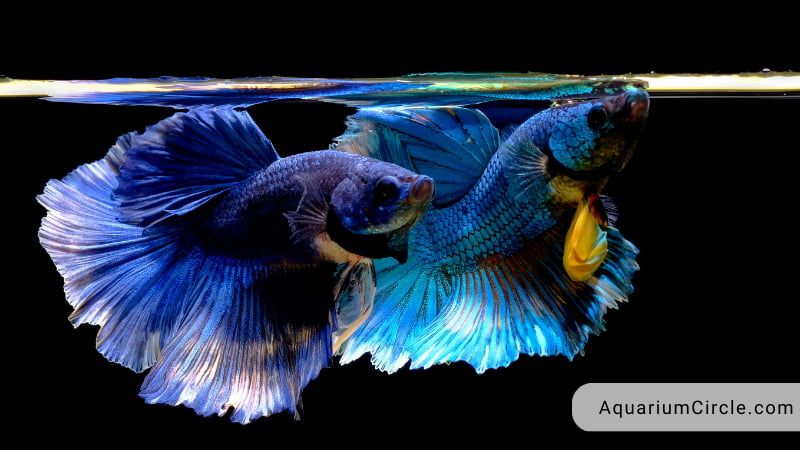
Another crucial aspect of distinguishing types of Bettas is the patterning of colors and scales on their body and fins. Some types have a relatively plain appearance, while others are exceptionally beautiful, with rarer patterns being more sought after and desirable. In the following sections, we will describe the commonly accepted patterns of Betta fish.
Bi-Colored Betta fish
The body of the Bi-Colored Betta fish is one color, while the fins are another. This can be achieved in two ways:
- Light Bi-Colored Betta: This variety has a light-colored body, with dark contrasting colors on the fins being preferred over light-colored fins.
- Dark Bi-Colored Betta: This variety has a solidly colored body in one of the six accepted solid colors, with either translucent or brightly colored fins. Contrasting colors to the body are preferred.
The fish in both light and dark Bi-Colored types should only have two colors, and any additional markings will result in disqualification if judged (except for darker shading on the head, which is seen in most specimens).
Butterfly Betta fish
The Butterfly pattern type is characterized by a single solid body color that extends into the base of the fins, stopping in a strong, distinct line. The rest of the fins are typically pale or translucent, creating a two-tone effect, resembling a second color band on the outer half of the fins.
Ideally, the split of color in the fins should be a 50/50 split, with half and half between the two colors. However, achieving this is rare, and a 20% leeway is accepted if being shown.
Cambodian Betta fish
The Cambodian pattern is a variation of the bi-colored pattern, but it’s distinctive enough to have its own name. It consists of a pale body, preferably flesh-colored white or light pink, paired with bright solid-colored fins, which are typically red. While other colors of fins can occur, they should still have a solid flesh-colored body.
Dragon scale Betta fish
The Dragon Scale Betta has a bright metallic color that sets it apart from other patterns. While the underlying body has a bright color, it isn’t as striking as other patterns. The thick scales on a Dragon Scale Betta give it a medieval appearance, even though it is one of the newest Betta breeds. The scales resemble armor, with a faint body color visible because of the white scales. The scales have dark edges, which add to the unique look of this Betta type.
Marble Betta fish
Marble Betta fish display blotchy or splash-like patterning all over their bodies, with a pale base color and vivid, solid-colored patterns such as red or blue. While marbling is necessary on the body of all marble kinds, it is not essential on the fins. Some have translucent fins, while others have marbling, and both varieties are acceptable. The marble Betta fish’s patterns can alter over time, which is very unique.
See also: Do Betta Fish Change Color: 4 Most Common Reasons
Mask Betta fish
The Mask pattern is significant because the faces of Betta fish are naturally darker than the main part of their body. The Mask variety, on the other hand, has faces that are the exact same shade and hue as the rest of their bodies, giving them a continuous, single color from head to tail. Although it can be seen in many other hues as well, this pattern is frequently seen in turquoise, blue, and copper variations.
Multicolored Betta fish
The Multicolored pattern type is used to describe any Betta that has three colors or more on their body and doesn’t fit into any other pattern type. This covers an incredible number of variations, making it difficult to list them all. Nonetheless, the description should give you a general idea of what to expect from this pattern type.
Piebald Betta fish
A Piebald Betta is one with a white or pinkish, flesh-colored face and a body of another color. The body of a Piebald fish is typically a solid dark color, but may have butterfly-like patterning on the fins or slight marbling.
Solid Betta fish
A Solid Betta fish has one single solid color all over its body, just as the name suggests. This pattern is most commonly seen in red individuals, but it can also be found in other colors.
Wild type Betta fish
The Wild Type pattern type is the most closely related to Betta splendens found in the wild, as the name suggests. They typically have a mostly dull red or brown as the main color for most of their body. However, there will be some blue and/or green iridescent scales on the fish, and some blue and red in the fins of a male.
See also: Battling Betta Fish Fin Rot: Symptoms, Causes And How To Cure Betta Fin Rot
Betta Fish Types By Color
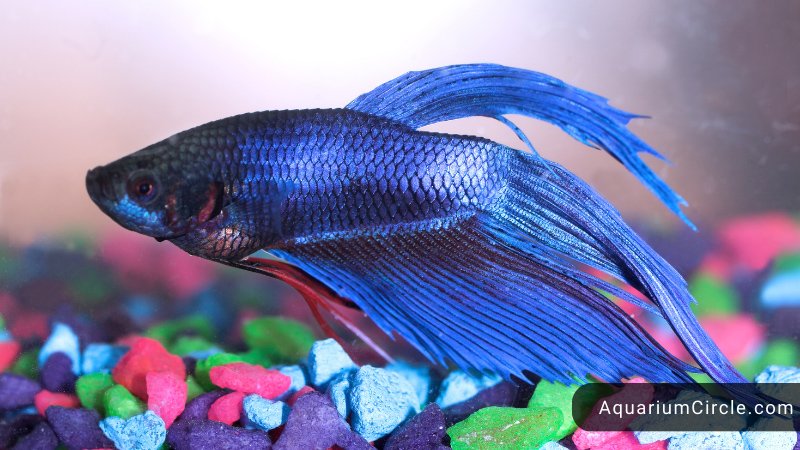
Although you may think you already know enough about colors, it’s not as simple as just “red,” “yellow,” or “blue” when it comes to Betta coloration. In this section, we will explore the main common Betta colors, as well as some of the more exotic ones that you may not have come across or considered before.
Black Betta fish
There are actually three types of black Betta: Melano (plain black and infertile), Black lace (which is fertile), and Metallic (or Copper) black, where the fish also has some iridescent scales. Melano is the most popular and deepest black of the three, where a gene has mutated to massively increase the amount of black pigment in the skin. Melano females being infertile means they can only be bred by Melano gene-carrying females of other varieties.
The Black lace Betta is also a nice deep color, though not quite as deep as the Melano. However, this variety isn’t infertile, unlike the Melano females, so it is more easily bred and therefore more readily available.
Blue / Steel Blue / Royal Blue Betta fish
Betta fish come in various shades of blue, ranging from a true blue wash to steel blue that appears cold and grayish. One of the most vibrant and richest blue shades is the Royal Blue Betta, characterized by its iridescent and bright blue coloring.
Clear / Cellophane Betta fish
The clear or cellophane betta fish has a transparent skin, which is why it is also called “cellophane.” It lacks pigmentation, which would make it colorless if not for the inner flesh of the fish shining through the translucent skin, giving it a pinkish, fleshy appearance. Cellophane bettas also have transparent fins and tails.
Some people may mistake this type for an albino betta, but they can be distinguished by the cellophane’s black eyes, while albinos have pink eyes like most true albino animals.
Chocolate Betta fish
The term “chocolate betta” is not an officially recognized type, but it is widely accepted and used. It usually refers to a betta with a brown body and either yellow or orange fins, making it a bicolor variety. However, there is a lot of confusion surrounding this term, as some people use it to describe bettas with almost black, dark green, or dark blue bodies, which would actually be categorized as “mustard gas” (discussed later on).
Copper Betta fish
The copper betta fish boasts an impressive level of iridescence, exhibiting a light gold or deep copper color with red, blue, and purple metallic highlights. They may appear silver or brown in weak light but display a dazzling copper sparkle under stronger lighting conditions.
Green Betta fish
It is rare to find true green color in betta fish, as what is often considered green is actually a shade of turquoise. Green can be difficult to distinguish in most betta types, appearing similar to other dark-colored fish, but it can be seen as an iridescent green shine under torchlight. Nonetheless, there are some highly prized and sought-after varieties of betta with a visible dark green color.
Mustard Gas Betta fish
Mustard gas bettas are a bi-colored variety that is considered unique enough to have its own name. This color pattern features a dark-colored body that can be blue, steel blue, or green, paired with yellow or orange fins. It is important to note that while some people mistakenly refer to this pattern as “chocolate,” the term should only be used for bettas with brown bodies.
Opaque / Pastels Betta fish
The opaque coloration is not a distinct color, but rather a result of a gene that produces a milky white layer over the base color. This means that opaque versions of all the main colors can be found in betta fish.
In some cases, this milky white layer gives the fish a pastel appearance, resulting in a type of betta called “pastels”.
Orange Betta fish
Betta fish with an orange coloration are not commonly found, but when they are, they usually have a vibrant tangerine-like shade. However, in low lighting conditions, they can appear reddish in color. To bring out their best color, it is recommended to provide them with decent strength, full-spectrum illumination.
Orange dalmatian Betta fish
The Orange Dalmatian betta is also known as “apricot spots” or “orange spotted betta”. These fish have a pale orange body and fins with brighter and deeper orange spots or streaks all over their fins. While their body and fins are predominantly pale orange, their fins have distinctive orange spots that resemble those of a Dalmatian.
White Betta fish
A white betta fish may seem less vibrant compared to other color variations. It has a pure white body and fins, which some may find plain. However, with the right tail type, it can still look majestic. Pairing a long, flowing, and swooping tail with the white coloration can create a stunning appearance. So, combining coloration and tail type can result in a beautiful and unique white betta fish.
Purple / Violet Betta fish
Finding true purple Betta Fish can be quite challenging as they are rare. However, you can find them in rich violet or purple-blueish shades, often combined with other colors such as copper or black. Sometimes, they have purple bodies and different-colored fins or face. These Bettas come in all types of tail types and color patterns, so you have a wide range of options to choose from depending on your preferences.
Red Betta fish
Betta fish commonly have a dominant red color, which is strikingly beautiful. Typically, they have a solid, bright red color all over their body, but sometimes red can be seen as a “red wash” in other colors, which is generally considered undesirable.
Turquoise Betta fish
Defining the color turquoise in betta fish can be challenging as it lies somewhere between blue and green. It may appear more green in some lighting conditions and more blue in others. One way to confirm if a betta is turquoise is by observing that it is too green to be considered blue, and shining a light on it to check for the absence of yellow shades. If there are any yellow shades, then it is more likely to be green rather than turquoise.
Wild-type Betta fish
In addition to describing some betta patterning, the term “wild-type” can also refer to a betta color. Wild-type bettas exhibit an iridescent green or blue body with some red and/or blue on their fins.
Pineapple & Yellow Betta fish
Yellow betta fish are often referred to as “non-red” and can range from a very pale yellow to a rich, buttery shade. Pineapple is a variation of yellow in which there is a darker outline around the scales, giving the fish a pattern similar to the scales on a pineapple.
Albino Betta fish
Albinism is a genetic condition that affects different species, including Betta fish. Albino Betta fish are characterized by their solid white color with no pigmentation, and their eyes appear pink or red. It is important to note that a white fish with black eyes is not an albino, but simply a white type.
Albino Betta fish are extremely rare and have a higher chance of going blind at a very early age. Due to their scarcity and breeding difficulties, they remain a sought-after type among Betta fish enthusiasts.
Video About Betta Fish Types
FAQs
What are Betta Fish?
Betta Fish, also known as Siamese Fighting Fish, are a popular freshwater fish that are native to Thailand and other parts of Southeast Asia. They are known for their vibrant colors, long fins, and aggressive behavior towards other Betta Fish.
What are the different types of Betta Fish?
There are several types of Betta Fish, including Siamese Fighting Fish, Plakat Betta Fish, Crown Tail Betta Fish, Half-Moon Betta Fish, Double Tail Betta Fish, Delta Tail Betta Fish, Super Delta Tail Betta Fish, Rosetail Betta Fish, Feather Tail Betta Fish, and Giant Betta Fish…
What are the physical characteristics of Betta Fish?
Betta Fish have a unique body shape and fin structure. They have elongated bodies and can grow up to 3 inches long. Betta Fish fins come in various shapes, sizes, and colors, and can be used to identify different Betta Fish types.
References

Annette M. Chaney is an experienced marine biologist with over 20 years of experience as an aquarist and fishkeeper. She started her first aquarium at a young age, filling it with frogs and goldfish obtained from the ten-cent pet store.
Annette grew up caring for and breeding African Cichlids, which led to a hobby in high school that doubled as a profitable means. Attending Reed College gave her time to solidify herself as an accomplished aquarium caretaker with an eye for sales. After that, from 2009 – 2013, she studied at Roger Williams University – one of the most prestigious universities for Aquaculture and Aquarium in USA. She is the founder of AquariumCircle since 2010.
